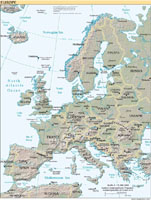| Welcome To The Irish Homepage |
|
|
|
|
| LINGUA E Crumlin College (IRL) and KTA Brugge (BEL) |
 Ireland Ireland
Introduction Land and Resources Economy Population Goverment History Things to see Ireland in Europe
|
  Ireland is situated right at the edge of Europe just off the Atlantic Ocean.
Ireland is situated right at the edge of Europe just off the Atlantic Ocean.
1973 Ireland joined the European Economic Community (European Community). In 2002 all the European currencies will be changed to the Euro the current form of currency in Ireland is the punt. Which is equal to 100 pence. Through the European Community, Ireland has a diversified economy in which agriculture predominates, although industry has become increasingly important the chief exports are foodstuffs (especially beef), electrical machinery, and chemicals, dairy products such as Michlestown cheese and Kerry Gold butter are sold all over Europe. Other industries include textiles, and tourism is also important. The country generates 15 per cent of its electricity by burning peat, of which there are extensive reserves. Until recently Ireland had a higher rate of emigration than any other member of the EU. However, the 1990s have seen a spectacular economic boom, with inflation remaining low in the period 1994-97 Ireland had the fastest growing economy in Europe. Irish citizens have had the right to reside, work, and vote in the UK since the independence. Joining the European Community was most certainly a wise move, it means that Ireland can borrow money from the European Bank. This Bank is only for countries not citizens, the Bank helps underdeveloped countries, and it's the other countries in which envest their money into the bank that pay for the loans to the countries. This bank helped Ireland grow rapidly Economy wise, with new roads and buildings being developed creating new jobs for the population.
International Organizations associated with Ireland:
|